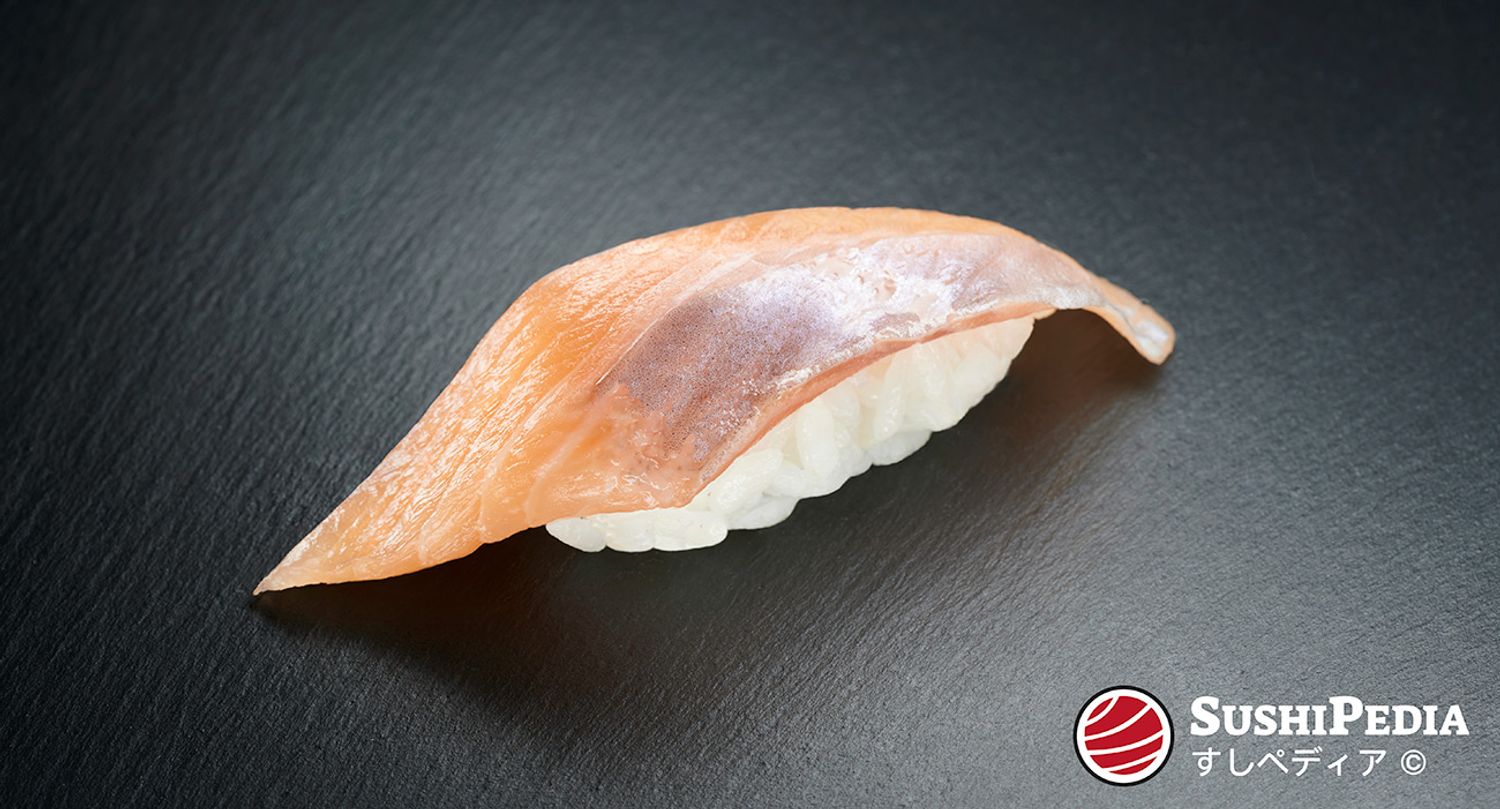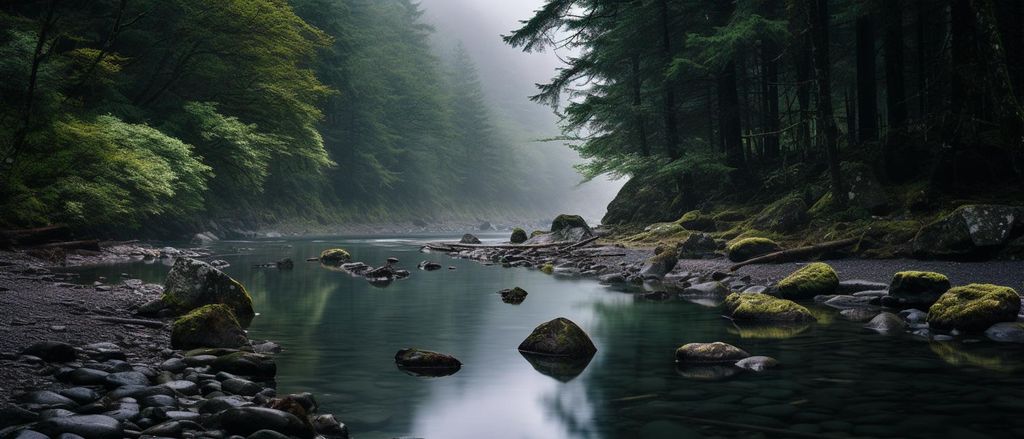Iwana Sushi
A Comprehensive Overview of Whitespotted Char, Char in Japanese Sushi Cuisine
イワナすし 、 岩魚(𩸶)寿司 
What is Iwana?
The Japanese term iwana 岩魚 refers to the genus of char (Salvelinus) within the family Salmonidae. This taxonomic classification includes various species of freshwater fish that are characterized by their adaptability to cool inland waters. Although in a strictly scientific context, iwana refers to the entire genus Salvelinus (iwana-zoku ⺅ワナ属), a narrower meaning has become established in the gastronomic field. Here, iwana is often used as a synonym for the Japanese char (Salvelinus leucomaenis), in Japanese amemasu ⾬鱒アメマス, a specific species within this genus, unless more precise distinctions are made regarding its subspecies. Known for its tender flesh and delicate flavor, Japanese char is a popular choice for traditional Japanese dishes such as sushi and sashimi.
Iwana for Sushi or Sashimi
The clear and shiny, white to reddish flesh of the iwana is characterized by a light and pleasing taste. Its smell is very neutral, while the aromas are restrained, which makes it particularly suitable for the preparation of “pressed sushi” (oshi sushi 押し寿司). Two methods can be used to refine sushi or sashimi made from iwana: dehydration using salt, which makes the meat firmer, or, although less common, enrichment with flavors using a relatively weak vinegar marinade. Iwana is not an everyday ingredient for sushi and is rather rare. It is most likely to be found in restaurants located near regional centers where iwana is fished or aquaculture farms exist.
Compared to salmon, which belongs to the same family, the taste of iwana is less full-bodied and more restrained. In particular, char that spend most of their lives in fresh water have a slightly “earthy” flavor. The condition of the water from which the fish were taken is responsible for these off-flavors. An earthy taste of fish meat can be explained by the presence of geosmin in the water. Geosmin is an organic compound produced by microorganisms such as Streptomyces species, cyanobacteria, and myxobacteria. These microorganisms are mainly found in the sediment of freshwater bodies. Fish absorb geosmin through their gills when they breathe and through their food. The compound can accumulate in fish flesh, causing the flesh to take on an earthy or musty taste. As the human perception threshold for geosmin is extremely low, even small amounts of the substance in fish flesh are sufficient to make this undesirable taste perceptible. Removing geosmin from water is a challenge, as it is a stable chemical compound that does not break down easily. As a result, the earthy taste in fish meat can also be persistent and difficult to remove.[1]
Best Season
The spawning season depends on the region and subspecies. It takes place in many tributaries of the main stream from October to January. In spring and summer, when the water temperature is high, the fish is fatty and tasty, but after October, when it enters the spawning season, the meat tastes a little less tasty [2].
Iwana offered on the market often come from aquaculture and are available most time of the year.
Iwana in Japan
Etymology
The name “iwana” is made up of the Japanese characters 岩 (iwa) and ⿂ (sakana). It is directly related to the natural environment and the biological characteristics of this fish species. The kanji 岩, which means “rock” or “stone”, reflects the preferred habitat of the iwana: cool, clear rivers and streams with plenty of rock, typically in mountainous regions. The second kanji, ⿂, means “fish” and is used as a generic term for different types of fish. The combination of these two kanji results in the name “rock fish” or “mountain stream fish”, which refers to the specific ecological niches in which the iwana thrives.
Iwana Trivia
Documentary Film: A Trout In The Milk
The Japanese documentary A Trout In The Milk ミルクの中のイワナ is a remarkable portrait of the life cycle and habitat of iwana and oshorokoma, オショロコマ, a subspecies of Dolly Varden trout. The work depicts the complicated relationships between the various species and their environment, linking ecological findings with the far-reaching effects of human activities. This multi-award winning documentary has been praised for its successful portrayal of the delicate balance of nature through the eyes of these trout species. It not only captivates viewers with its storytelling, but also educates them about the critical issues facing freshwater biodiversity in Japan. The film has been praised by experts including Yōro Takeshi 養老孟司 and Junichi Tsuboi 坪井潤一, who have been campaigning for the preservation of biodiversity in Japan for decades. According to them, the film underlines the deep connection with its protagonists and makes it a must-see for anyone interested in the intersection of nature, culture and environmental responsibility.[3]
Characteristics & Ecology of Iwana

SushiPedia. Home of the Iwana: The pristine rivers of Japan. All rights reserved ©
Iwana prefers fast flowing, oxygen-rich, cool and clear waters with gravel or sand bottom. They are fast swimming predators that feed on small organisms, water insects, other fish, insects falling from shore trees and frogs.
Some iwana populations live anadromous, that means they migrate from saltwater to freshwater for spawning, these are called amemasu アメマス in Japanese. The term ezo iwana エゾイワナ is used to describe groups of iwana living in landlocked freshwater areas. Ezo iwana prefers rivers and streams with a water temperature below 15 °C. The distribution in rivers extends over different regions of Honshu and Hokkaido. In addition, the natural habitat includes the northeastern Korean peninsula via Sakhalin, the Kuril Islands to Kamchatka in the Northwest Pacific.
Subspecies of Japanese Iwana
Iwana, scientifically classified as Salvelinus leucomaenis, includes several subspecies native to the Japanese archipelago and its inland waters. These characteristic fish of the genus Salvelinus have adapted to the various aquatic ecosystems of Japan, from the cold, clear rivers and streams of the mountainous regions to the more southerly waters of the Kii Peninsula. Each subspecies is characterized by unique features and adaptations that allow it to exist in its specific habitat.
Amemasu and Ezo Iwana
The Japanese subspecies S. leucomaenis leucomaenis is called amemasu アメマス. It is the nominate subspecies within the Iwana classification. A nominotypic subspecies, also called nominotypic subspecies, is the standard or reference subspecies within a species from which the species was originally described. In biological taxonomy, the nominal subspecies is considered to be the one most closely associated with the first description of the species itself. This classification serves as a reference point for comparison with other subspecies of the same species that may live in other geographical regions or under different ecological conditions. The nominate subspecies bears the same scientific name as the species, followed by a third name identical to that of the species to emphasize its position as the nominate subspecies.
The distribution area in Japan is limited to the regions north of Yamagata Prefecture along the Sea of Japan and north of Chiba Prefecture along the Pacific Ocean. Among the subspecies of iwana, Amemasu is the only one where an explicit distinction is made between an anadromous form, which returns to the rivers to spawn after two or more years in the sea, and a land-bound form, the ezo iwana エゾイワナ. The land-bound or river-resident form is found in Japan north of Chiba along the Pacific Ocean and beyond Yamagata along the Sea of Japan. Their habitat extends to the east coast of the Korean Peninsula, across Sakhalin, the Kuril Islands and Kamchatka, to the rivers that flow into the Sea of Okhotsk and the Bering Sea. Amemasu can reach a length of up to 70 cm, in comparison the river-residual form is about half the size. The anadromous form of the amemasu descends into the sea in its second year of life, spends two or more years there, and returns to the rivers to spawn.[4]
Nikkō Iwana
The subspecies nikkō iwana ニッコウイワナ (S. leucomaenis pluvius) is widespread in the mountainous regions from the Tōhoku region to the Kantō region and further into the prefectures of Shiga and Tottori. Characteristic of the nikkō iwana are the clearly visible yellowish-orange or pinkish spots on the sides. They are also characterized by larger orange to pale pink spots that extend from the flanks to the belly. They inhabit the Sea of Japan north of the Hinogawa River (Tottori), the Pacific Ocean north of the Fujigawa River (Yamanashi) or the Sagamigawa River (Kanagawa).[4]
Yamato Iwana
Regional populations of the iwana or the subspecies S. leucomaenis japonicus, which live in the rivers of the mountainous regions on the Pacific side of the central main island of Honshū, reach a body length of 25 cm. In contrast to other regional iwana populations, the white spots are less conspicuous. Instead, smaller red spots are occasionally found on the flanks. This particular population is endemic to the Kii Peninsula in the center of Honshū in Japan and is called yamato iwana ヤマトイワナ. In English, this subspecies is known as kirikuchi char. This subspecies represents the southernmost population of the genus Salvelinus and is considered a relict in its distribution area. However, other subspecies of Japanese char (S. leucomaenis) have been introduced into the habitat of yamato iwana, resulting in strong hybridization. Due to anthropogenic disturbances, the distribution area of the yamato iwana is now limited to the two upper river systems of the Totsu River on the Kii Peninsula and the subspecies is threatened with extinction.[5]
Gogi
The subspecies S. leucomaen imbrius of iwana, known as gogi ゴギ, is native to the headwaters of the mountainous regions within the Chgoku region of Japan. Specifically in the prefectures of Shimane, Okayama, Hiroshima, and Yamaguchi. Like the other subspecies, distinctive white spots characterize it. These spots extend from the sides across the back to the head. They reach a body length of around 20 cm. The southwestern distribution boundary of gogi in Japan is the Takatsu River in Shimane Prefecture, while on the Seto Inland Sea side, the boundary is the Nishiki River in Yamaguchi Prefecture.[4]
Warnings related to Iwana
Video about Iwana Sushi
External video embedded from: youTube.com. Credit さばけるチャンネル. 岩魚(いわな)のさばき方:大名卸し - How to filet Char ver. Daimyo Oroshi -|日本さばけるプロジェクト.
Species of Iwana
The following species are regarded as authentic iwana. Either historically, according to the area of distribution or according to the common practice in today's gastronomy:
Sources and Further Reading
- [1]Mikael A. Petersen , Md. Ariful Alam , Md. Mizanur Rahman , Md. Lokman Ali , Sultan Mahmud , Louise Schlüter , Niels O. G. Jørgensen. Geosmin off-flavour in pond-raised fish in southern Bangladesh and occurrence of potential off-flavour producing organisms. Aquaculture Environment Interactions 5 107–116. DOI: 10.3354/aei00100.
- [2]『ペロリンの山形旬情報《イワナ》|おいしい山形ホームページ (Perorin's Yamagata Seasonal Information《Iwana》|Delicious Yamagata Home Page)』. おいしい山形推進機構事務局、 2015-02-25. Source retrieved 1/17/2022
- [3]The Light Source. 『『A TROUT IN THE MILK / ミルクの中のイワナ』公式サイト』. 2024. Source retrieved 3/21/2024
- [4]Yoshikazu Fujioka. Trout and Seasons of The Mountain Village - Profile of Iwana. Source retrieved 3/21/2024
- [5]Takuya Sato, Teruko Demise, Hitoshi Kubota, Makoto Nagoshi, Katsutoshi Watanabe. Hybridization, Isolation, and Low Genetic Diversity of Kirikuchi Char, the Southernmost Populations of the Genus Salvelinus. Transactions of the American Fisheries Society 139 (13) 1758-1774. DOI: 10.1577/T09-086.1.
- [6]桜田 紀元. 『渓流魚(ヤマメ・イワナ)の寄生線虫 田経済法科大学 (Parasitic nematodes of mountain stream fish (landlocked salmon and char, Yamame Iwana))』. Akita Economic Law University / Akita Junior College (秋田経済法科大学・秋田短期大学論叢). 1984
- Fish and Fishery Products Hazards and Controls Guidance. U.S. Department of Health and Human Services Food and Drug Administration Center for Food Safety and Applied Nutrition. 2020
- Takeichiro Kafuku, Ikenoue Hiromu. Modern Methods of Aquaculture in Japan, Volume 24. Elsevier Science, Amsterdam. 1992
- 昌髙藤原. 『ぼうずコンニャクの市場魚貝類図鑑 (Bozu Konyaku's Market Fish and Shellfish Book)』. Bozu Konnyaku Co., Ltd., Tokyo ぼうずコンニャク株式会社東京, zukan-bouz.com、 2020. Source retrieved 12/27/2021
- IUCN Red List of Threatened Species. Version 2023-1
Image Credits
- SushiPedia. Iwana Sushi. All rights reserved ©
- SushiPedia. Home of the Iwana: The pristine rivers of Japan. All rights reserved ©